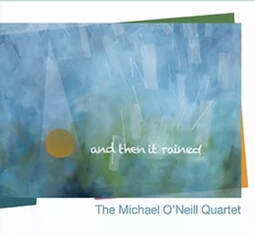
Those artists are Michael O'Neill on tenor, alto, soprano saxes and clarinet, Michael Bluestein (of Foreigner fame) on piano, Dan Feiszli on bass, and Jason Lewis on drums. Don’t be surprised by Michael Bluestein’s piano. While he may be a rock star, he can play Jazz beautifully and inspiringly. All of the songs were composed and produced by Michael O’Neill.
The album opens beautifully with Port of Spain. Based upon Michael’s desire to visit Trinidad and Tobago—a trip that was never realized—O’Neill takes on the parts intended for steel pans with his soprano sax. Bluestein carries the Latin chords solidly with the Feiszli and Lewis bass and drums. They set a high bar from the opening track and never come down.
While not diminishing what O’Neill has recorded before, his original compositions prove to be worth the wait and leave you wanting to hear more from his pen.
Emerging Impressions gives a good spotlight to Feiszli’s bass and Bluestein’s piano before being joined by O’Neill’s tenor sax. As the title suggests, a bit of classical Impressionism is easily discernible in this remarkable piece by O’Neill. The rhythm section is sterling and Lewis on drums is worthy of special attention. Bluestein’s piano solo is gorgeous and O’Neill’s tenor sax paints sonic eddies with wondrously subdued tones and tempos.
Early Spring puts you in a Bill Evans frame of mind, echoing his Very Early. O’Neill is back on soprano sax and he and Bluestein prove their musical camaraderie in all the right ways. The play between them is delightful and makes you crave even more. Again, Feiszli and Lewis prove why they are on this album.
One for Kenny was written for O’Neill’s pal Kenny Washington (Feiszli contributed to Washington’s 2020 album What’s the Hurry). Bluestein turns in some fantastic piano riffs and runs and O’Neill definitely brings Washington’s voice to mind through his alto sax. The whole quartet lights this one up as O’Neill and Bluestein echo each other’s parts nicely and Feiszli and Lewis push the groove. Kenny must be proud.
Cloud Scape is a bit of a Jazz tone poem with an Impressionistic look at clouds seen from an airplane. You have to Feiszli’s bass solo here as Bluestein chords delicately beneath. O’Neill has written a wonderful melody and he, with the quartet, expounds on it beautifully.
However, the title track And Then It Rained is truly something amazing. Feiszli opens the piece with a beautifully bowed bass before O’Neill comes in with the soprano sax. It sounds like what he would have seen had he successfully made the trip to Port-of-Spain. A nice, tropical rain shower with nobody getting wet on this track. This is a true beauty.
Staying with the watery themes, Maverick’s Samba is O’Neill’s vision of the surf break at Half Moon Bay near San Francisco. The alto sax carries the waves and Bluestein nails the breaks while bass and drums pound the surf. This may be the most fun song on the album.
Song for Mama Bear is an homage to Jazz patron Pegi Brandley. It is at once sweet and determined. Feiszli gets his coolest bass solo of the album and O’Neill’s soaring soprano sax is spot on.
O’Neill pays tribute to his honored quartet inspirations with Four Cornered Circle. The tenor sax evokes the sounds and ‘scapes of Coltrane while the Quartet turn in their best impressions of Tyner, Garrison, Elvin Jones and more. While O’Neill is surely referencing more than Coltrane, the Trane spirit is clearly present. Can’t get enough of this one.
Sweet Iris sees O’Neill at his reminiscent best in a song that recalls a rental house that was provided to him below market by a landlord who was helping O’Neill’s musical career with below-market rent. Lewis gets a monster drum solo that he takes full advantage of while O’Neill’s clarinet is bouncy, lively, and grateful.
The album closes with The Dreams We Left Behind. It is warm and reflective as O’Neill works a sometimes melancholy, now musing, tenor sax and Bluestein’s piano carries the melodic memories beautifully. O’Neill says, “The Dreams We Left Behind was written in the aftermath of a failed relationship.” He calls it “an amalgam of all the choices and changes of direction we make in life.” Not precisely melancholy or wistful, the song is most assuredly reflective.
And Then It Rained is one gorgeous album. The Quartet is remarkable and the compositions are varied and inspired. Michael O’Neill has given a great contribution to those suffering through the dumpster-fire year of 2020. O’Neill breathes life and hope in the midst of reflection and we are grateful.
~Travis Rogers, Jr. is The Jazz Owl

 RSS Feed
RSS Feed
